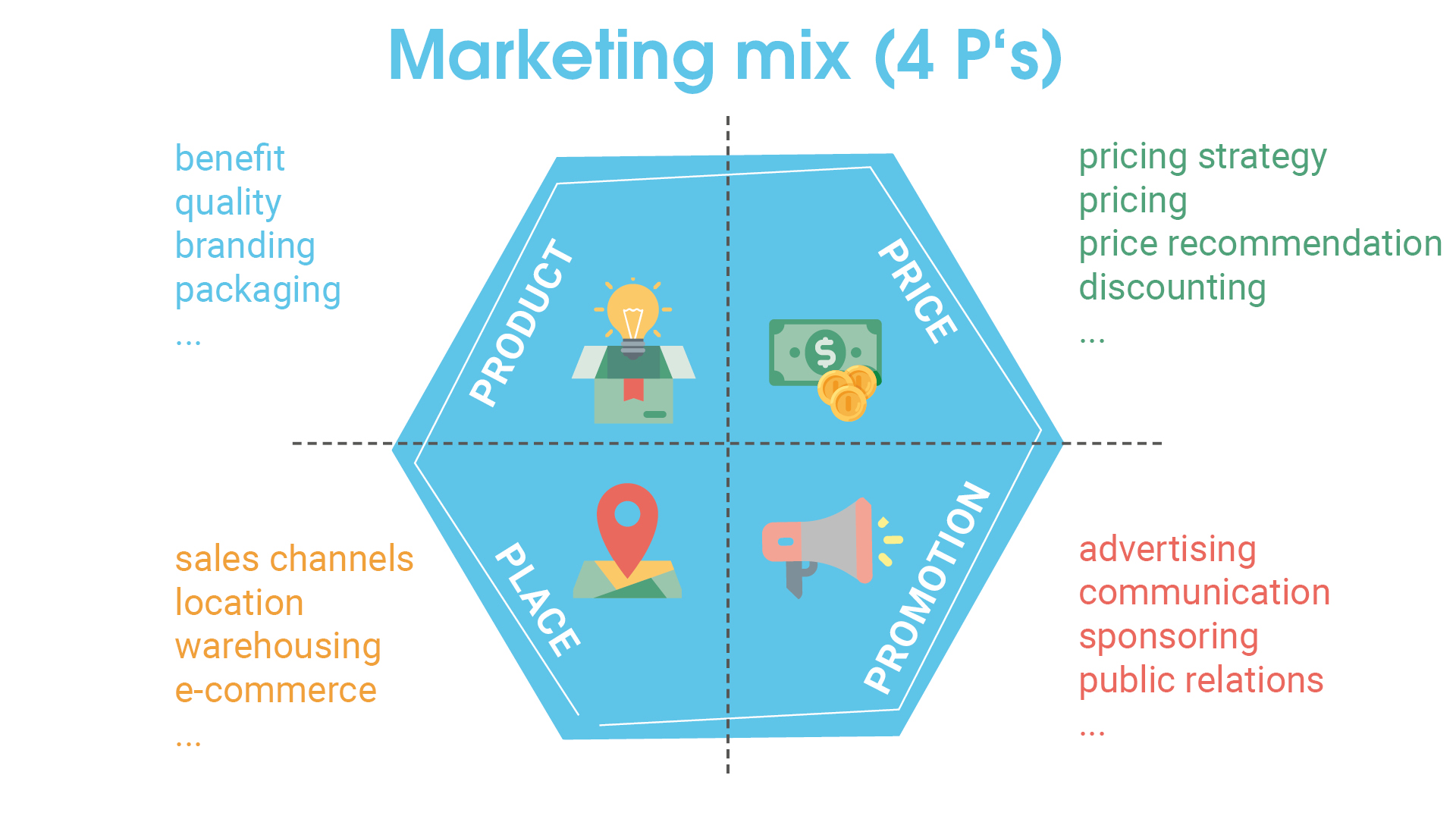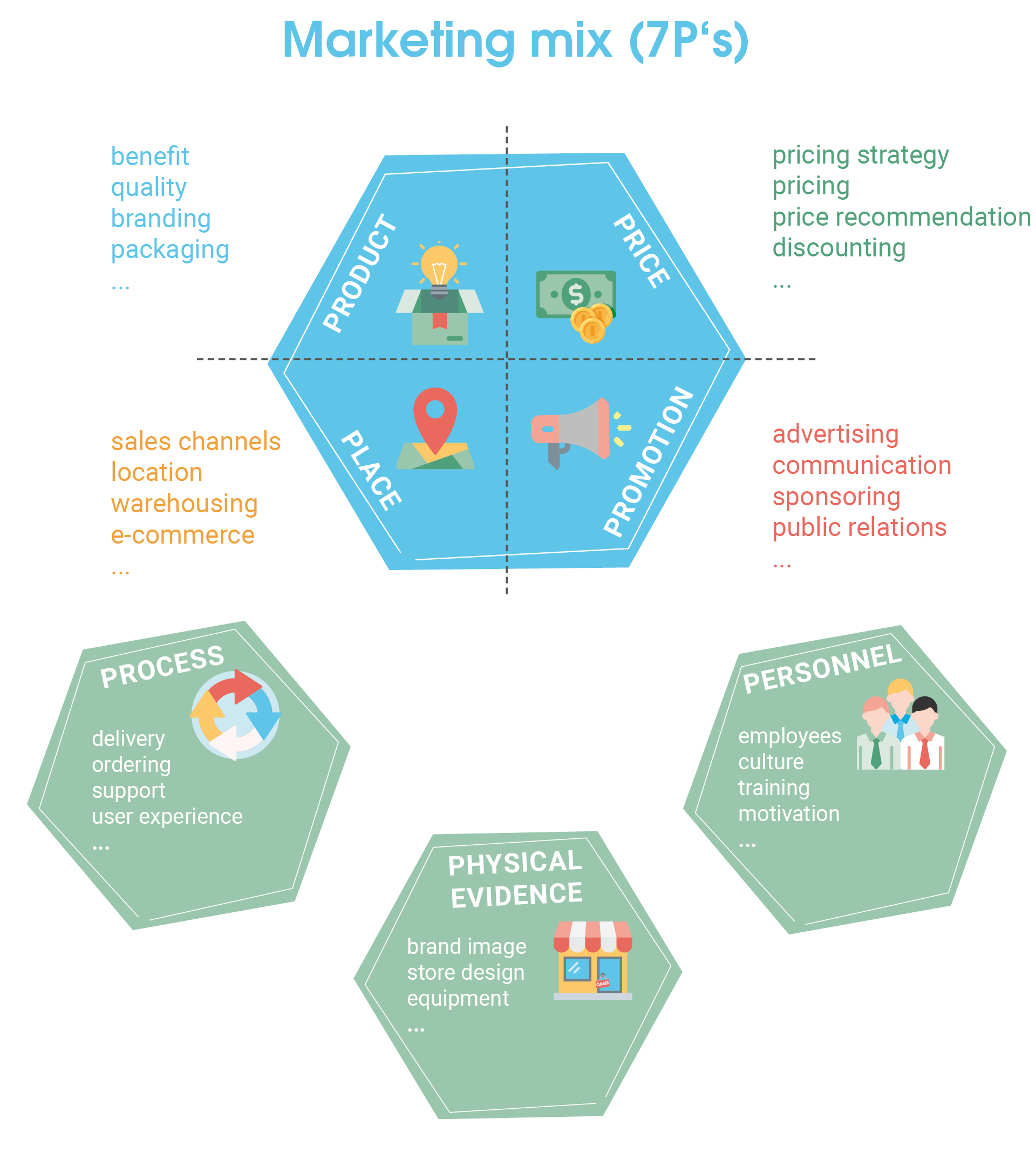SERP refers to the results page of a search engine. All important information about SERPS and how to optimize your SERP snippets, you can learn here! ... Continue reading




The marketing mix was first developed by Neil Borden, an American marketing researcher, in the 1950s. Borden described the marketing mix as a combination of marketing tools that a company uses to market its product or service.
Later, Jerome McCarthy refined Borden’s idea and developed the concept of the 4 Ps in the marketing mix: product, price, promotion, and placement. This concept was adopted by many companies in the 1960s and has served as the basis for developing marketing strategies ever since.
Since then, the Marketing Mix has continued to evolve and various approaches and additions have been added, such as the expansion to seven marketing tools (Product, Price, Promotion, Placement, Process, People and Physical Evidence). Today, the mix is a fundamental tool in the field of marketing and helps companies align their marketing strategies and successfully achieve their marketing goals.
The four P’s in the marketing mix stand for product, price, promotion and placement. Product refers to what the company offers, while price refers to the amount a customer must pay for the product. Promotion refers to how the company advertises the product, and placement refers to how the product is made available to the customer. Together, these four elements form the basis of a successful marketing strategy by ensuring that the product meets the needs and wants of the customer, is competitive and is marketed effectively.

The product refers to what the company offers. The aim here is to design the product or service in such a way that it meets the needs and wants of the customers. Factors such as the quality, design and packaging of the product must also be taken into account. In particular, the product life cycle plays an extremely important role in planning the product strategy. A successful product policy is always based on customer benefit and how the product solves the problems of the target group. When designing the product policy, several factors must be considered:
The price is the amount a customer has to pay for the product. The company has to find the right price to make both profits and remain competitive. Factors such as discounts, promotions and payment terms must also be considered in the pricing strategy. The aim is not only to make a profit, but also to set the price in line with the expectations of the target group and the competitive environment. Important strategies in pricing policy are:
Promotion is the way in which the company advertises the product or service – in other words, the communication channels. The aim is to appeal to the target group and persuade them to buy the product. Various advertising media such as TV commercials, advertisements, posters, PR or online marketing are used. The communication policy must be consistent and adapted to the target group in order to have the greatest possible influence on purchasing behaviour. Important instruments of communication policy are:
Placement refers to how the product is made available to the customer. The aim here is to find the right distribution channel and the right distribution partners to bring the product to the customer. The choice of distribution channels and distribution strategies plays a central role here. Companies must decide whether they want to sell their products directly (via their own channels) or indirectly (via intermediaries). Factors such as availability and the presentation of the product at the point of sale must also be taken into account. Here are the most important aspects:

Process policy (Process): Process policy encompasses all activities that ensure that a product or service is efficiently created and provided to the customer. It deals with the optimisation of internal processes and customer interaction during the provision of the service. It is crucial that the process runs smoothly, quickly and in a customer-oriented manner. Here are some key elements:
People: The HR policy focuses on the management and development of employees who are directly or indirectly involved in the provision of a product or service. Particularly in the service sector, employees play a crucial role in the marketing mix, as they have a significant influence on customer satisfaction and brand perception. Important aspects of HR policy include:
Physical Evidence: The physical evidence refers to the physical elements that the customer encounters during the service experience or purchase. This includes the appearance of business premises, online presences or even the packaging of the product. These physical cues play a major role in how the customer perceives the company and the product. Aspects of the physical evidence are:
These seven marketing tools ensure that a company develops and implements a successful marketing strategy that is aligned with the needs and desires of its customers and end users and remains competitive.
The classic marketing mix with its 4P’s – product, price, placement and promotion – remains one of the most important foundations in marketing. However, changing consumer behaviour and advancing digitalisation have led to the development of alternative models that are more responsive to customer needs and offer new approaches to marketing strategy. In particular, the 4C model and the SAVE model put the customer at the centre and offer a more developed perspective on how marketing should work today.
The 4C model puts the customer at the centre of the marketing strategy. It focuses on customer needs and replaces the product-oriented 4P’s with a customer-oriented view.
The SAVE model offers an alternative to the 4 Ps, placing more emphasis on providing solutions and added value than on pure product marketing.
These alternative models show a clear shift from a product-oriented to a customer-oriented marketing approach, which, in view of current trends and changing consumer behaviour, represents a timely further development of the classic marketing mix.
The marketing mix is an essential tool for companies to develop and implement a successful marketing strategy. Here are some aspects of why it is so important:
Clarity: the mix model helps companies define and implement their marketing strategy in a clear and understandable way. It gives them a structure and a roadmap that allows them to align their marketing activities as well as achieve their goals more effectively.
Target group orientation: The marketing mix tools help companies to align their marketing activities with the needs and wishes of their target group. By taking into account customer needs in the areas of product, price, promotion and placement, it can ensure that it successfully addresses its target group.
Competitiveness: the model helps to remain competitive by allowing companies to adapt their marketing strategy to changing market conditions and the needs of their customers. Constantly reviewing the marketing mix can ensure that they are always up to date and maintain their competitive advantage.
Profitability: 5P Marketing or 7P Marketing helps companies maximize their profitability by allowing them to focus their marketing efforts on the most impactful and profitable areas. Optimizing the marketing mix can ensure that companies use their budget wisely and achieve the best possible results.
In conclusion, marketing mix helps companies align their marketing activities, effectively reach their target audience and remain competitive, ultimately leading to higher profitability.
Never miss the hottest news again.